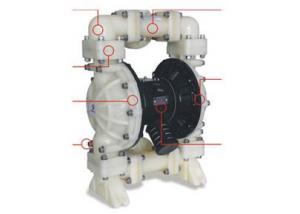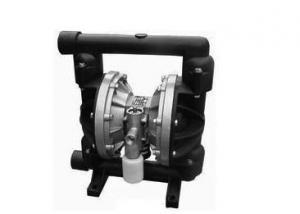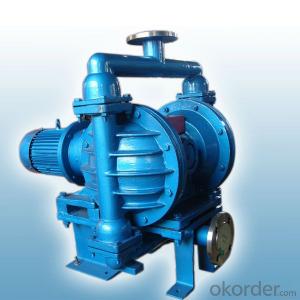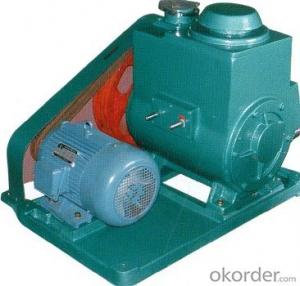Plastic Diaphragm Pump
- Loading Port:
- China Main Port
- Payment Terms:
- TT or LC
- Min Order Qty:
- 1 unit unit
- Supply Capability:
- 1000 Per Month unit/month
OKorder Service Pledge
OKorder Financial Service
You Might Also Like
Details for Plastic Diaphram Pump
1, Package and delivery of Plastic Diaphram Pump
1) Packed with standard exporting wooden case, requested package will be acceptable.
2) Delivery date will be within 30 days after receiving the prepayment.
2, Technical specification of Plastic Diaphram Pump
1) Size: 3/8-4 inch.
2) Flow: 16L/Min-400L/Min.
3) Head: 0-50m.
3, The features about Plastic Diaphram Pump
1) Three section manifold, Flexible installation. Can change to be 4 ports pump.
2) Enhanced structural Strength, the plastic pumpbody is durable.
3) Solid flange connection, strong and durable.
4) Raw material is PP-H which low temperature resistance, high temperature resistance, chemical resistance, wearing resistance better than PP.
5) Liquid chamber and manifold adop 4 bolts connection. Good seal and good dry suction.
6) The bolts of plastic pump are of Stainless steel 304.
7) We can supply PP-H pump and PVDF pump from 1/2" to 3".
4, The advantages about our Plastic Diaphram Pump
1) Four bolts connection with very round ball, well seal and good dry suction. The actual dry suction can reach to 4~7m.
2) High roundness valve ball for use the ball mill machine.
3) Three section manifold, Flexible installation and even can simultaneously convey two different liquids.
4) Longer diaphragm life. Diaphragm material from Dopont, Exxon.
5) Pilot type air valve, low maintenance, low air consumption, so the using cost is low.
6) Wetted body: PPH, PVDF, SS304, SS316, Aluminum etc.
7) Diaphragm: PTFE, Hytrel, Santoprene, Viton etc.
- Q: Can an air pump be used for inflating air-filled inflatable advertising characters?
- Yes, an air pump can be used for inflating air-filled inflatable advertising characters. An air pump is specifically designed to inflate objects with air, making it an ideal tool for inflating inflatable advertising characters. This type of pump can provide a continuous flow of air, allowing for quick and efficient inflation. Additionally, air pumps often come with different nozzle attachments, which can make it easier to inflate various sizes and types of inflatables. It is important, however, to ensure that the air pump you use is compatible with the specific requirements of the inflatable advertising character, such as the recommended PSI (pounds per square inch) and airflow rate.
- Q: Can an air pump be used for inflating air pools with built-in water slides?
- Yes, an air pump can be used for inflating air pools with built-in water slides. Air pumps are commonly used to inflate various inflatable items, including air pools. The built-in water slides in the pool do not affect the ability to use an air pump for inflation. The air pump will provide the necessary air pressure to inflate the pool, making it ready for use.
- Q: Can an air pump be used for inflatable dance costumes?
- Yes, an air pump can be used to inflate dance costumes that are designed to be inflated.
- Q: How does an air pump handle varying air densities?
- An air pump handles varying air densities by adjusting its internal mechanisms to regulate the amount of air it pumps based on the surrounding air density.
- Q: Can an air pump be used for inflatable bouncy castles?
- Indeed, inflatable bouncy castles can make use of an air pump. In reality, it stands as the prevailing and effective means to inflate them. Air pumps are purposefully engineered to deliver a consistent airflow, allowing for the rapid inflation of the bouncy castle. They are available in diverse sizes and variants, encompassing electric and manual options. Utilizing an air pump guarantees the proper inflation of the bouncy castle, thereby establishing a secure and pleasurable playground for both youngsters and adults.
- Q: How does an air pump handle back pressure during inflation?
- An air pump handles back pressure during inflation by utilizing a combination of design features and mechanisms. When an air pump is connected to an inflatable object, such as a balloon or a tire, and pressure is applied to the pump, the air is forced into the object, causing it to inflate. However, during this process, back pressure can occur, which is the resistance or counterforce exerted by the object being inflated. To handle back pressure, air pumps are designed with specific components and features. One common feature is a one-way valve, also known as a check valve, which allows air to flow in only one direction. This valve prevents backflow of air from the object being inflated back into the pump, ensuring that the air only moves in the desired direction. Additionally, air pumps may incorporate pressure relief valves or pressure regulators. These mechanisms help control the pressure by releasing excess air when the pressure inside the object reaches a certain level. This prevents overinflation and potential damage to the object being inflated. Furthermore, the design of the pump's piston or diaphragm plays a crucial role in handling back pressure. These components are engineered to create a tight seal when pressure is applied, ensuring minimal air leakage and maximizing the efficiency of the inflation process. The materials used in constructing the pump, such as rubber or other flexible materials, help provide a secure seal and reduce the effects of back pressure. Overall, air pumps are designed to effectively handle back pressure during inflation by incorporating one-way valves, pressure relief valves, and well-designed pistons or diaphragms. These features work together to ensure a smooth and efficient inflation process while preventing damage to the pump and the object being inflated.
- Q: Can an air pump be used for pneumatic braking systems in trains?
- Indeed, pneumatic braking systems in trains can utilize an air pump. These systems depend on compressed air to initiate and regulate the brakes. The duty of the air pump is to create the necessary pressure for the functioning of the braking system. As the train operator activates the brakes, the air pump compresses the air and dispatches it to the brake cylinders. Consequently, the brake pads interact with the wheels, resulting in a decrease in speed or a complete halt of the train. Thus, the air pump plays a vital role in ensuring the safety and efficiency of the pneumatic braking system in trains.
- Q: Can an air pump be used for inflating air mattresses with raised edges?
- Yes, an air pump can be used for inflating air mattresses with raised edges. Air pumps are designed to inflate various inflatable objects, including air mattresses. They usually come with different nozzle attachments to fit different types of valves on the inflatable items. By using the appropriate attachment, an air pump can easily inflate an air mattress with raised edges. It is important to follow the manufacturer's instructions and recommendations to ensure proper inflation and avoid any potential damage to the mattress or the pump.
- Q: How does an air pump handle different inflation pressure settings?
- An air pump is designed to handle different inflation pressure settings by adjusting the amount of air it pumps into an object based on the desired pressure level. This is usually achieved through the use of a pressure gauge or a digital display on the pump itself. When you set a specific pressure level on the pump, it will automatically monitor the current pressure inside the object and adjust the airflow accordingly. If the pressure is below the desired level, the pump will increase the airflow to inflate the object until it reaches the set pressure. On the other hand, if the pressure is above the desired level, the pump will decrease the airflow to prevent over-inflation and maintain the specified pressure. To achieve this, air pumps are equipped with various mechanisms like valves and regulators that control the airflow and pressure. These mechanisms ensure that the pump can accurately measure and adjust the inflation pressure based on the set level. In addition to manual pressure settings, some air pumps also have preset inflation options for specific objects like sports balls, bicycles, or inflatable mattresses. These presets are programmed to provide the optimal pressure level for each object, making it easier for the user to inflate them correctly without worrying about over or under-inflation. Overall, an air pump handles different inflation pressure settings by continuously monitoring and adjusting the airflow based on the desired pressure level, ensuring that the object being inflated is properly inflated without any damage or issues.
- Q: How does an air pump handle different auto shut-off mechanisms?
- An air pump is designed to handle different auto shut-off mechanisms by either providing a manual shut-off option or by automatically sensing the pressure of the tire being inflated and stopping the air flow once the desired pressure is reached.
Send your message to us
Plastic Diaphragm Pump
- Loading Port:
- China Main Port
- Payment Terms:
- TT or LC
- Min Order Qty:
- 1 unit unit
- Supply Capability:
- 1000 Per Month unit/month
OKorder Service Pledge
OKorder Financial Service
Similar products
Hot products
Hot Searches
Related keywords



























